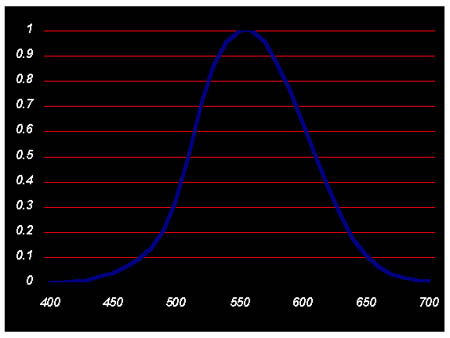
Optical Electrical Measurement FAQ:
1. What is human eye response (V (l)) sensor used for?
2. What can we do if the light signal to be measured is very small?
1. What is human eye response (V (l)) sensor used for?
Most of the light source used in daily life are designed for human to see or to read, so it is reasonable to describe these light sources by " how do human eyes feel about these lights?". Since human eyes are pretty similar to photo sensors, so they also have spectral response to various wavelength of light. Typical spectral response of human eye is shown in figure 1, it's peak response is around 555nm (green-yellow light), i.e., green-yellow light has the highest illumination efficiency for human eyes.
V lambda sensor is composed of a silicon photo diode with well matched color filter and it has almost same spectral response with human eye. Therefore, we can use V lambda sensor to estimate "how human eye feel about this light source". Human eye response based units includes nits, lumen, lux, and candle can all be measured by a V lambda sensor with proper setup and careful calibration.
Figure 1 Spectral Response of Human Eye

2. What can we do if the light signal to be detected is very small?
For some cases, we shall measure very small light signal, usually, three methods can be used to improve the sensitivity of the testing system!
First is to increase the active area of the detector so we can improve the signal level.
Second is to adopt photo multiplication tube (PMT), the detected and generated electrons can be amplified by the following multiplication process in PMT. The possible noise comes from the thermal emission of the multiplication plate or the stray light of the system.
Third is to use lock-in amplifier, we put a rotating chopper to modulate the signal light to become sinusoidal (frequency can be set from several hertz to several kilo hertz). The chopped light is detected by a detector and convert sinusoidal light to sinusoidal current signal. Lock-in amplifier locks the sinusoidal signal and amplifies it. Therefore, we can get a amplified signal with very low noise power spectrum.
